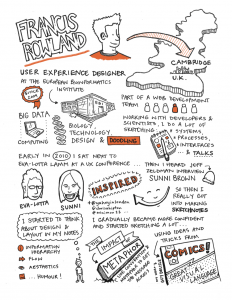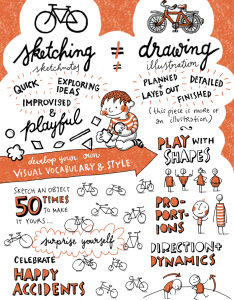My thoughts on the Sketchnoting Handbook
I have recently read the Sketchnoting Handbook by Mike Rhodes and I have accumulated some great tips, tricks and notes on how to improve my note taking skills. Throughout reading the book I have written notes and important tips that I want to remember, here are the key points I have taken from this book-
What are sketchnotes?
Sketchnotes are rich visual notes created from a mix of hand writing, drawings, hand-drawn type, visual elements like arrows and boxes and using shapes.
Why should I sketchnote?
I want to start sketchnoting as I have read that the process engages your brain more, and it activates verbal and visual modes. They are visual maps that get the mind and body working together, preventing distractions and can maximise learning, recall and the ability to discover/capture the BIG ideas.
How to sketchnote?
In this book the act of sketchnoting was explained in 3 simple steps:
- Listen
- Synthesise
- Visualise
So basically to sketch note a lecture or talk for example I need to listen to others ideas, build on their ideas myself and then visualise new ideas!
Materials I need to sketchnote:
- Pen- no pencil!!
- Sketchbook
It is about the ideas I have and not the art I create while sketchnoting.
The Sketchnoting process:
- Research
- Gather materials
- Arrive early
- Create a tittle
- Sketchnote
- Photograph
- Scan and share
The book then got into a deeper level of information about how to sketch note and I have recorded the main points of the sketchnoting process above and to a beginner this process sounds complicated but I need to just keep practicing and trying out my own style and personalising my own sketchnotes every time I complete them.
Drawing exercise
The book included drawing exercises at the end that I tried out for sketch noting practise and I had to sketch items in my kitchen and office using the 5 basic elements highlighted in the book. I used a pen and not a pencil which was unsettling at first but I have included my attempts below.
Examples of sketchnoting I like:
By reading this book I was able to see a range of sketchnote examples from designers all over the world, I thought that this was lovely feature as I got to see how professional artists and designers take their notes. Within the book there was a wide variety of style and personality within the notes which was very influential to see and read.
What did I learn?
I have gained a lot of knowledge from reading this book and I thoroughly enjoyed it! The overall concept of sketchnoting is new to me but it sounds very intriguing and such a useful tool to know how to do as a designer and I do want to practice this technique more and more, by using this technique when listening to talks or lectures. I have learned it has many benefits and will help me better my overall skills as a designer, illustrator and learner. The most important message that I learned is that note taking and sketching can be fun, and with practice I can make it a fun learning experience.




